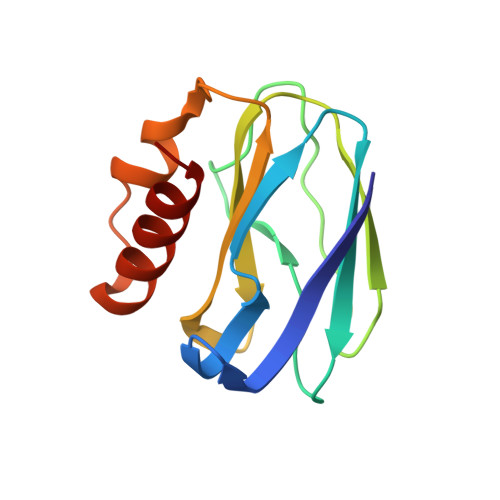Influence of Loop Shortening on the Metal Binding Site of Cupredoxin Pseudoazurin.
Velarde, M., Huber, R., Yanagisawa, S., Dennison, C., Messerschmidt, A.(2007) Biochemistry 46: 9981
- PubMed: 17685636
- DOI: https://doi.org/10.1021/bi701113w
- Primary Citation of Related Structures:
2UX6, 2UX7, 2UXF, 2UXG - PubMed Abstract:
Atomic resolution structures of the pseudoazurin (PAZ) variant into which the shorter ligand-containing loop of amicyanin (AMI) is introduced have been determined. The mutated loop adopts a different conformation in PAZAMI than in AMI. The copper site structure is affected, with the major influence being an increased axial interaction resulting in the shortest Cu(II)-S(Met) bond observed for the cupredoxin family of electron-transfer proteins. This is accompanied by a lengthening of the important Cu-S(Cys) bond and enhanced tetragonal distortion, consistent with the influence of the PAZAMI loop contraction on the UV/vis spectrum. The change in active site geometry is the major cause of the 50 mV decrease in reduction potential. The copper site structure changes very little upon reduction, consistent with the distorted site still possessing the properties required to facilitate rapid electron transfer. The exposed His ligand on the loop protonates in the reduced protein and reasons for the increased pKa compared to that of PAZ are discussed. The area surrounding the His ligand is more hydrophobic in PAZAMI than in PAZ, while electron self-exchange, which involves homodimer formation via this surface patch, is decreased. The nature of the side chains in this region, as dictated by the sequence of the ligand-containing loop, is a more significant factor than hydrophobicity for facilitating transient protein interactions in PAZ. The structure of PAZAMI demonstrates the importance of loop-scaffold interactions for metal sites in proteins.
Organizational Affiliation:
Abteilung Proteomics und Signaltransduktion, Max-Planck-Institut für Biochemie, Am Klopferspitz 18, 82152 Martinsried, Germany.

















